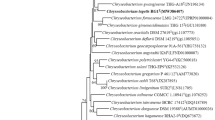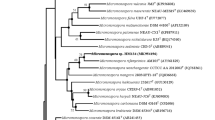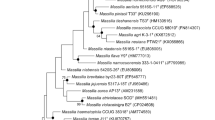Abstract
A yellow-pigmented, non-motile, Gram-stain-negative, pleomorphic bacterium, designated RP-3-3T was obtained from soil sampled at the Arctic region in Cambridge Bay, NU, Canada. The strain is strictly aerobic, psychrotolerant, grow optimally at 15–20 °C and produces flexirubin type pigments. The strain is able to hydrolyse CM-cellulose, casein, starch and DNA. Strain RP-3-3T showed antimicrobial activity against Gram-negative pathogens. A phylogenetic analysis based on its 16S rRNA gene sequence revealed that strain RP-3-3T formed a lineage within the family Weeksellaceae and clustered as members of the genus Chryseobacterium. The closest members were Chryseobacterium shigense DSM 17126T (98.7% sequence similarity), Chryseobacterium carnipullorum DSM 25581T (98.7%) and Chryseobacterium oncorhychi 701B-08T (98%). The genome is 4,910,468 bp long with 73 scaffolds and 4300 protein-coding genes. The anti-SMASH analysis of whole genome showed ten putative biosynthetic gene clusters responsible for various secondary metabolites. The sole respiratory quinone is MK-6. The major cellular fatty acids are iso-C15:0, iso-C17:1 ω9c, iso-C17:0 3-OH, summed feature 3 (iso-C15 :0 2-OH/C16 :1ω7c) and anteiso-C15:0. The major polar lipid is phosphatidylethanolamine. The DNA G + C content of the type strain is 36.9 mol%. In addition, the average nucleotide identity and in silico DNA–DNA hybridization relatedness values between strain RP-3-3T and phylogenetically closest members are below the threshold value for species delineation. Based on genomic, chemotaxonomic, phenotypic and phylogenetic analyses, strain RP-3-3T represents novel species in the genus Chryseobacterium, for which the name Chryseobacterium antibioticum sp. nov. is proposed. The type strain is RP-3-3T (=KACC 21620T = NBRC 114360T).
This is a preview of subscription content, access via your institution
Access options
Subscribe to this journal
Receive 12 print issues and online access
$259.00 per year
only $21.58 per issue
Buy this article
- Purchase on Springer Link
- Instant access to full article PDF
Prices may be subject to local taxes which are calculated during checkout



Similar content being viewed by others
References
Prestinaci F, Pezzotti P, Pantosti A. Antimicrobial resistance: a global multifaceted phenomenon. Pathog Glob Health. 2015;109:309–18.
Dahal RH, Chaudhary DK. Microbial infections and antimicrobial resistance in Nepal: current trends and recommendations. Open Microbiol J. 2018;12:230–42.
Terra L, et al. A novel alkaliphilic Streptomyces inhibits ESKAPE pathogens. Front Microbiol. 2018;9:2458.
O’ Neil J. Antimicrobial resistance: tackling a crisis for the health and wealth of nations. Rev Antibiot Resist. 2014;1–16. [Available online: https://amr-review.org/sites/default/files/AMR%20Review%20Paper%20-%20Tackling%20a%20crisis%20for%20the%20health%20and%20wealth%20of%20nations_1.pdf]
Naylor NR, et al. Estimating the burden of antimicrobial resistance: a systematic literature review. antimicrob resist infect control. BioMed Cent. 2018;7:58.
Genilloud O. Actinomycetes: still a source of novel antibiotics. Nat Prod Rep. 2017;34:1203–32.
Vandamme P, Bernardet JF, Segers P, Kersters K, Holmes B. New perspectives in the classification of the flavobacteria: description of Chryseobacterium gen. nov., Bergeyella gen. nov., and Empedobacter nom. rev. Int J Syst Evol Microbiol. 1994;44:827–31.
Holmes B, Owen RJ, Steigerwalt AG, Brenner DJ. Flavobacterium gleum, a new species found in human clinical specimens. Int J Syst Evol Microbiol. 1984;34:21–5.
Nguyen NL, Kim YJ, Hoang VA, Yang DC. Chryseobacterium ginsengisoli sp. nov., isolated from the rhizosphere of ginseng and emended description of Chryseobacterium gleum. Int J Syst Evol Microbiol. 2013;63:2975–80.
Montero-Calasanz M, del C, et al. Chryseobacterium oleae sp. nov., an efficient plant growth promoting bacterium in the rooting induction of olive tree (Olea europaea L.) cuttings and emended descriptions of the genus Chryseobacterium, C. daecheongense, C. gambrini, C. gleum, C. joostei, C. jejuense, C. luteum, C. shigense, C. taiwanense, C. ureilyticum and C. vrystaatense. Syst Appl Microbiol. 2014;37:342–50.
Hahnke RL, et al. Genome-based taxonomic classification of Bacteroidetes. Front Microbiol. 2016;7:2003.
Nicholson AC, et al. Division of the genus Chryseobacterium: observation of discontinuities in amino acid identity values, a possible consequence of major extinction events, guides transfer of nine species to the genus Epilithonimonas, eleven species to the genus Kaistella, and three species to the genus Halpernia gen. nov., with description of Kaistella daneshvariae sp. nov. and Epilithonimonas vandammei sp. nov. derived from clinical specimens. Int J Syst Evol Microbiol. 2020;70:4432–50.
Meng D, Liu YL, Li RR, Gu PF, Fan XY, Huang ZS, et al. Chryseobacterium binzhouense sp. nov., isolated from activated sludge. Int J Syst Evol Microbiol. 2020;70:618–23.
Zamora L, Fernández-Garayzábal JF, Palacios MA, Sánchez-Porro C, Svensson-Stadler LA, Domínguez L, et al. Chryseobacterium oncorhynchi sp. nov., isolated from rainbow trout (Oncorhynchus mykiss). Syst Appl Microbiol. 2012;35:24–9.
Charimba G, Jooste P, Albertyn J, Hugo C. Chryseobacterium carnipullorum sp. nov., isolated from raw chicken. Int J Syst Evol Microbiol. 2013;63:3243–9.
Quan ZX, Kim KK, Kim MK, Jin L, Lee ST. Chryseobacterium caeni sp. nov., isolated from bioreactor sludge. Int J Syst Evol Microbiol. 2007;57:141–5.
Shimomura K, Kaji S, Hiraishi A. Chryseobacterium shigense sp. nov., a yellow-pigmented, aerobic bacterium isolated from a lactic acid beverage. Int J Syst Evol Microbiol. 2005;55:1903–6.
Chaudhary DK, Kim J. Chryseobacterium nepalense sp. nov., isolated from oil-contaminated soil. Int J Syst Evol Microbiol. 2017;67:646–52.
Gandhi Pragash M, Narayanan KB, Naik PR, Sakthivel N. Characterization of Chryseobacterium aquaticum strain PUPC1 producing a novel antifungal protease from rice rhizosphere soil. J Microbiol Biotechnol. 2009;19:99–107.
Kim HS, Sang MK, Jung HW, Jeun YC, Myung IS, Kim KD. Identification and characterization of Chryseobacterium wanjuense strain KJ9C8 as a biocontrol agent of Phytophthora blight of pepper. Crop Prot. 2012;32:129–37.
Chaudhari PN, Wani KS, Chaudhari BL, Chincholkar SB. Characteristics of sulfobacin A from a soil isolate Chryseobacterium gleum. Appl Biochem Biotechnol. 2009;158:231–41.
Chen FL, Wang GC, Teng SO, Ou TY, Yu FL, Lee WSen. Clinical and epidemiological features of Chryseobacterium indologenes infections: analysisof 215 cases. J Microbiol Immunol Infect. 2013;46:425–32.
Yasmin S, Garcia G, Sylvester T, Sunenshine R. Chryseobacterium indologenes in a woman with metastatic breast cancer in the United States of America: a case report. J Med Case Rep. 2013;7:190.
Sharma P, Gupta SK, Diene SM, Rolain JM. Whole-genome sequence of Chryseobacterium oranimense, a colistin-resistant bacterium isolated from a cystic fibrosis patient in France. Antimicrob Agents Chemother. 2015;59:1696–706.
Lin JN, Lai CH, Yang CH, Huang YH. Differences in clinical manifestations, antimicrobial susceptibility patterns, and mutations of fluoroquinolone target genes between Chryseobacterium gleum and Chryseobacterium indologenes. Antimicrob Agents Chemother. 2019;63:e02256-18.
Jain V, Hussain NAFA, Siddiqui T, Sahu C, Ghar M, Prasad KN. Simultaneous isolation of Chryseobacterium gleum from bloodstream and respiratory tract: first case report from India. JMM Case Rep. 2017;4:e005122.
Dahal RH, Kim J. Glaciihabitans arcticus sp. nov., a psychrotolerant bacterium isolated from Arctic soil. Int J Syst Evol Microbiol. 2019;69:2492–7.
6Dahal RH, Chaudhary DK, Kim J. Pinisolibacter ravus gen. nov., sp. nov., isolated from pine forest soil and allocation of the genera Ancalomicrobium and Pinisolibacter to the family Ancalomicrobiaceae fam. nov., and emendation of the genus Ancalomicrobium Staley 1968. Int J Syst Evol Microbiol. 2018;68:1955–62.
Frank JA, Reich CI, Sharma S, Weisbaum JS, Wilson BA, Olsen GJ. Critical evaluation of two primers commonly used for amplification of bacterial 16S rRNA genes. Appl Environ Microbiol. 2008;74:2461–70.
Yoon SH, Ha SM, Kwon S, Lim J, Kim Y, Seo H, et al. Introducing EzBioCloud: A taxonomically united database of 16S rRNA gene sequences and whole-genome assemblies. Int J Syst Evol Microbiol. 2017;67:1613–7.
Pruesse E, Peplies J, Glöckner FO. SINA: accurate high-throughput multiple sequence alignment of ribosomal RNA genes. Bioinformatics. 2012;28:1823–9.
Kumar S, Stecher G, Tamura K. MEGA7: molecular evolutionary genetics analysis version 7.0 for bigger datasets. Mol Biol Evol. 2016;33:1870–4.
Doetsch RN. Determinative methods of light microscopy. In: Gerdhardt P, Murray RGE, Costilow RN, Nester EW, Wood WA, Krieg NR, et al., editors. Manual of methods for general bacteriology. Washington, DC, USA: American Society for Microbiology; 1981. p. 21–33.
Smibert RM, Krieg NR. Phenotypic characterization. In: Gerhardt P, Murray RGE, Wood WA, Krieg NR, editors. Methods for general and molecular bacteriology. Washington DC, USA: American Society for Microbiology; 1994. p. 607–54.
Dahal RH, Kim J. Dyadobacter flavus sp. nov. and Dyadobacter terricola sp. nov., two novel members of the family Cytophagaceae isolated from forest soil. Arch Microbiol. 2018;200:1067–74.
Reichenbach H. The order cytophagales. In: Balows A, Trüper HG, Dworkin M, Harder W, Schleifer KH, editors. The prokaryotes. New York: Springer; 1992. p. 3631–75.
Sasser M. Bacterial identification by gas chromatographic analysis of fatty acid methyl esters (GC-FAME). MIDI tech note 101. Newark: MIDI Inc; 1990.
Minnikin DE, O’Donnell AG, Goodfellow M, Alderson G, Athalye M, Schaal A, et al. An integrated procedure for the extraction of bacterial isoprenoid quinones and polar lipids. J Microbiol Methods. 1984;2:233–41.
Komagata K, Suzuki K. 4 lipid and cell-wall analysis in bacterial systematics. Methods Microbiol. 1988;19:161–207.
Bankevich A, Nurk S, Antipov D, Gurevich AA, Dvorkin M, Kulikov AS, et al. SPAdes: a new genome assembly algorithm and its applications to single-cell sequencing. J Comput Biol. 2012;19:455–77.
Zhang Z, Schwartz S, Wagner L, Miller W. A greedy algorithm for aligning DNA sequences. J Comput Biol. 2000;7:203–14.
Lee I, Chalita M, Ha S-M, Na S-I, Yoon S-H, Chun J. ContEst16S: an algorithm that identifies contaminated prokaryotic genomes using 16S RNA gene sequences. Int J Syst Evol Microbiol. 2017;67:2053–7.
Tatusova T, DiCuccio M, Badretdin A, Chetvernin V, Nawrocki EP, Zaslavsky L, et al. NCBI prokaryotic genome annotation pipeline. Nucleic Acids Res. 2016;44:6614–24.
Aziz RK, Bartels D, Best AA, DeJongh M, Disz T, Edwards RA, et al. The RAST server: rapid annotations using subsystems technology. BMC Genom. 2008;9:75.
Yoon S-H, Ha S-M, Lim J, Kwon S, Chun J. A large-scale evaluation of algorithms to calculate average nucleotide identity. Antonie Van Leeuwenhoek. 2017;110:1281–6.
Meier-Kolthoff JP, Auch AF, Klenk H-P, Göker M. Genome sequence-based species delimitation with confidence intervals and improved distance functions. BMC Bioinform. 2013;14:60.
Grant JR, Stothard P. The CGView server: a comparative genomics tool for circular genomes. Nucleic Acids Res. 2008;36:W181–4.
Schattner P, Brooks AN, Lowe TM. The tRNAscan-SE, snoscan and snoGPS web servers for the detection of tRNAs and snoRNAs. Nucleic Acids Res. 2005;33:W686–9.
Lagesen K, Hallin P, Rødland EA, Stærfeldt H-H, Rognes T, Ussery DW. RNAmmer: consistent and rapid annotation of ribosomal RNA genes. Nucleic Acids Res. 2007;35:3100–8.
Blin K, Shaw S, Steinke K, Villebro R, Ziemert N, Lee SY, et al. antiSMASH 5.0: updates to the secondary metabolite genome mining pipeline. Nucleic Acids Res. 2019;47:W81–7.
Kanehisa M, Goto S. KEGG: Kyoto encyclopedia of genes and genomes. Nucleic Acids Res. 2000;28:27–30.
Richter M, Rosselló-Móra R. Shifting the genomic gold standard for the prokaryotic species definition. Proc Natl Acad Sci USA. 2009;106:19126–31.
Acknowledgements
We acknowledge the DASAN, Korean Arctic Station (Korea Polar Research Institute) for providing Arctic soil samples. We greatly appreciate Prof. Aharon Oren (The Hebrew University of Jerusalem, Israel) for his expert suggestions concerning the correct species epithet and etymology.
Funding
This research was supported by Basic Science Research Programme through the National Research Foundation of Korea (NRF-2019R1F1A1058501).
Author information
Authors and Affiliations
Corresponding author
Ethics declarations
Conflict of interest
The authors declare that they have no conflict of interest.
Ethical approval
This study does not describe any experimental work related to human.
Additional information
Publisher’s note Springer Nature remains neutral with regard to jurisdictional claims in published maps and institutional affiliations.
GenBank/EMBL/DDBJ accession for the 16S rRNA gene sequence of strain RP-3-3T is MN685329 and Whole Genome Shotgun project has been deposited at DDBJ/ENA/GenBank under the accession JABBGI000000000. The version described in this paper is version JABBGI010000000.
Supplementary information
Rights and permissions
About this article
Cite this article
Dahal, R.H., Chaudhary, D.K., Kim, DU. et al. Chryseobacterium antibioticum sp. nov. with antimicrobial activity against Gram-negative bacteria, isolated from Arctic soil. J Antibiot 74, 115–123 (2021). https://doi.org/10.1038/s41429-020-00367-1
Received:
Revised:
Accepted:
Published:
Issue Date:
DOI: https://doi.org/10.1038/s41429-020-00367-1
This article is cited by
-
Coculture and Immobilization of Cellulolytic Bacteria for Enhanced Glucose Isomerase Production from Wheat Straw
Biotechnology and Bioprocess Engineering (2023)
-
Chryseobacterium tagetis sp. nov., a plant growth promoting bacterium with an antimicrobial activity isolated from the roots of medicinal plant (Tagetes patula)
The Journal of Antibiotics (2022)
-
Compendium of specialized metabolite biosynthetic diversity encoded in bacterial genomes
Nature Microbiology (2022)
-
Genome insight and description of antibiotic producing Massilia antibiotica sp. nov., isolated from oil-contaminated soil
Scientific Reports (2021)
-
Whole-genome sequence and broad-spectrum antibacterial activity of Chryseobacterium cucumeris strain MW-6 isolated from the Arabian Sea
3 Biotech (2021)



